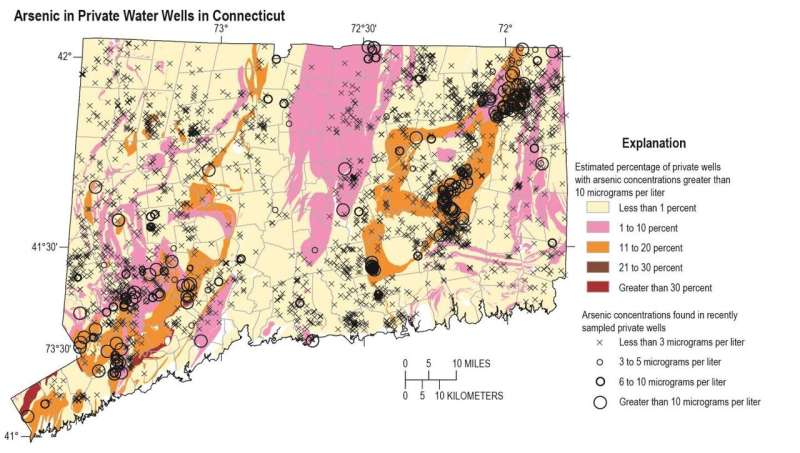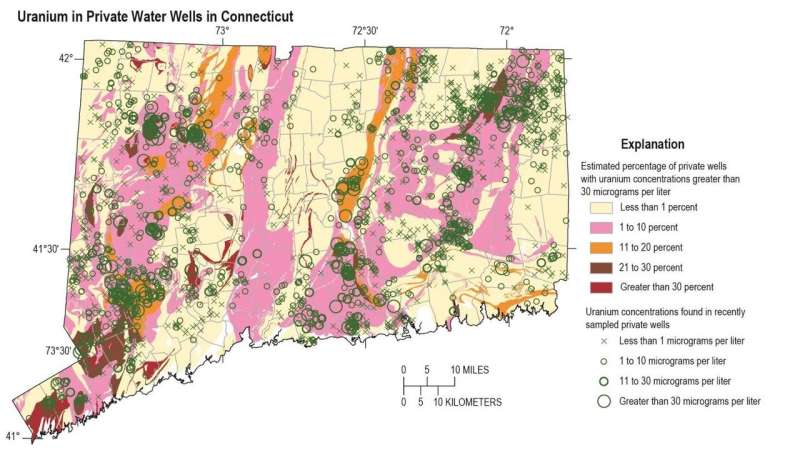New report shows high levels of arsenic and uranium in some wells

A new U.S. Geological Survey study provides an updated, statewide estimate of high levels of naturally occurring arsenic and uranium in private well water across Connecticut. This research builds on a USGS report published in 2017, with the new study including additional groundwater samples and focusing on previously underrepresented areas.
The research, undertaken in cooperation with the Connecticut Department of Public Health, projects that approximately 3.9% of private wells across Connecticut contain water with arsenic at concentrations higher than the U.S. Environmental Protection Agency's maximum contaminant level for public drinking-water supplies. This research also projects that 4.7% of private wells in the state have uranium concentrations higher than the EPA's standards.
CT DPH officials urge all private well owners to have their water tested for possible arsenic and uranium.
Arsenic and uranium are naturally occurring metals in bedrock around the world. Sometimes wells drilled into bedrock aquifers can produce water containing arsenic or uranium. Unless wells are tested, there's no way to confirm the presence or absence of these contaminants.
According to the CT DPH, Centers for Disease Control and Prevention, EPA and other health experts, there are potential health risks when concentrations of arsenic and uranium in groundwater used for drinking are higher than established human-health standards. Arsenic exposure has been related to increased cancer risk, low birth weight, decreased child intellectual development, immune system suppression and other adverse health outcomes. Ingestion of uranium, such as through drinking water, has been associated with kidney disease.

Data from this study can be used to better estimate the number of people potentially affected by high concentrations of naturally occurring arsenic and uranium in water from private wells.
An estimated 23% of Connecticut residents have private wells for their water supply. During the study, the CT DPH, with help from its state laboratory and local health officials, collected and analyzed water samples from more than 2,000 private wells throughout the state. Where high levels of arsenic or uranium were detected, state and local health officials worked with participating residents to inform and assist them with remedial measures to protect their water supply.
"This report provides essential tools to citizens, health officials, well drillers, government officials and others for better protecting their communities and the environment," said Eliza Gross, USGS physical scientist and lead author of the study. "The previous USGS study published in 2017 identified some areas where there were high contaminant levels, and we now have a more complete statewide assessment."
"Even though we know there are areas across our state that have higher concentrations than others, any private well in Connecticut has the potential to have elevated arsenic or uranium," said Ryan Tetreault, CT DPH Private Well Program supervisor. "Private well owners should have their well water tested at least once for these contaminants."
The CT DPH recommends that if tested well water has arsenic at a level greater than federal and state standards, an alternate source of water should be used or a treatment system should be installed. Also, if uranium in well water is at a concentration greater than the EPA standard of 30 micrograms per liter, the water should be treated to remove the uranium.
To ensure accuracy in the assessment, researchers separated Connecticut into grid cells for what's called a "spatially weighted analysis": a process that ensures areas with clusters of samples aren't overrepresented in a statewide estimate.
The USGS also found that certain bedrock types are more likely than others to yield high concentrations of arsenic and uranium in groundwater.
"While bedrock geology is not always predictive of higher or lower concentrations of arsenic or uranium in groundwater, knowing that certain geologic settings have a high likelihood can help inform decisions, such as drilling new wells, planning for development or deciding whether to conduct additional water-quality testing," said Gross. "This insight on geologic settings can also be applied to research in other states."
According to the CT DPH, routine testing for private well water does not usually include testing for arsenic and uranium; it is up to private well owners to have their well water additionally tested for these contaminants. The CT DPH also encourages new homebuyers to ask for such testing when purchasing a home with a private well. Under Connecticut law, the local director of health has the authority to require testing for arsenic and uranium in water from newly drilled wells if they have reason to believe there is a problem in their town.
State officials recommend that homeowners with private wells contact an environmental lab approved to test water.
More information: Eliza L. Gross et al, Arsenic and uranium occurrence in private wells in Connecticut, 2013–18—A spatially weighted and bedrock geology assessment, (2020). DOI: 10.3133/ofr20201111
Provided by United States Geological Survey




















